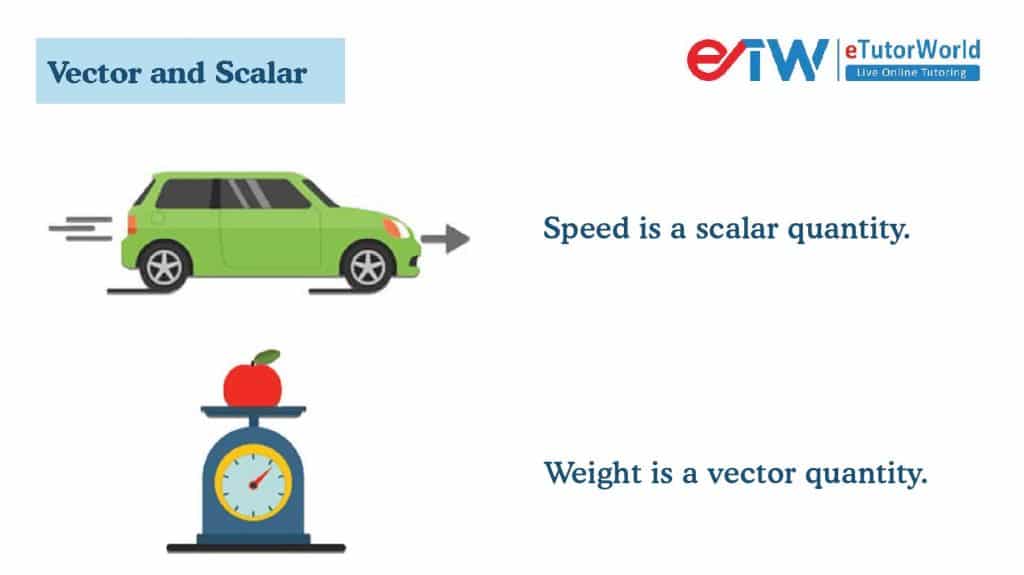Vector and Scalar
Grade 9 Science Worksheets
A Vector is a mathematical object that has both magnitude and direction. A Scalar is a quantity that is represented by a single numerical value and does not have a direction associated with it.
Table of Contents:
- Vector
- Formula of Vector
- Scalar
- Formula of Scalar
- Relationship between Vector and Scalar
- FAQs
Vector and Scalar - Grade 9 Science Worksheet PDF
This is a free printable / downloadable PDF worksheet with practice problems and answers. You can also work on it online.
|
|
Untimed |
|
Sign up with your email ID to access this free worksheet.
"We really love eTutorWorld!"
"We really love etutorworld!. Anand S and Pooja are excellent teachers and are quick to respond with requests to tutor on any math topic!" - Kieran Y (via TrustSpot.io)
"My daughter gets distracted easily"
"My daughter gets distracted very easily and Ms. Medini and other teachers were patient with her and redirected her back to the courses.
With the help of Etutorworld, my daughter has been now selected in the Gifted and Talented Program for the school district"
- Nivea Sharma (via TrustSpot.io)
Vector
In mathematics, a vector is a mathematical object that has both magnitude and direction. Vectors are typically represented as directed line segments, with the length of the line segment representing the magnitude of the vector and the direction of the line segment representing the direction of the vector.
Here are some examples of vectors:
- Velocity: The velocity of an object is a vector because it has both magnitude (speed) and direction.
- Force: A force acting on an object is a vector because it has both magnitude and direction.
- Displacement: The displacement of an object from its initial position to its final position is a vector because it has both magnitude (the distance traveled) and direction.
- Electric field: The electric field around a charged object is a vector because it has both magnitude and direction.
- Wind velocity: The velocity of the wind is a vector because it has both magnitude and direction.
- Magnetic field: The magnetic field around a magnet is a vector because it has both magnitude and direction.
- Gravitational force: The force of gravity acting on an object is a vector because it has both magnitude and direction.
These are just a few examples of vectors. Vectors are used in many fields of science and mathematics, including physics, engineering, and computer science.

Formula of Vector
To calculate a vector, you need to know its magnitude and direction.
One way to represent a vector is to use Cartesian coordinates, which consist of an x-coordinate, a y-coordinate, and a z-coordinate (if working in three dimensions). If you have the Cartesian coordinates of a vector, you can calculate its magnitude using the Pythagorean theorem:
Magnitude = √(x^2 + y^2 + z^2)
where x, y, and z are the x-coordinate, y-coordinate, and z-coordinate of the vector, respectively.
To calculate the direction of a vector, you can use trigonometry. One common way to represent the direction of a vector is to use its components in terms of the unit vectors i, j, and k (which point in the x-, y-, and z-directions, respectively).
The components of a vector can be found by projecting the vector onto each of the unit vectors. For example, if you have a vector v, its components can be calculated as:
v_x = v ⋅ i
v_y = v ⋅ j
v_z = v ⋅ k
where ⋅ represents the dot product. The direction of the vector can then be represented using the angles between the vector and each of the unit vectors.
Another way to represent the direction of a vector is to use its direction cosines, which are the cosines of the angles between the vector and each of the coordinate axes. The direction cosines can be calculated as:
cos(α) = v_x / Magnitude
cos(β) = v_y / Magnitude
cos(γ) = v_z / Magnitude
where α, β, and γ are the angles between the vector and the x-, y-, and z-axes, respectively.
These are just a few methods for calculating vectors. The specific method used will depend on the context and the information that is available about the vector.
Scalar
In mathematics, a scalar is a quantity that is represented by a single numerical value, and does not have a direction associated with it. Scalars are used to describe quantities that can be measured by magnitude alone, without reference to any particular direction.
Here are some examples of scalars:
- Temperature: The temperature of an object is a scalar quantity because it can be measured using a single numerical value, such as degrees Celsius or Fahrenheit.
- Mass: The mass of an object is a scalar quantity because it can be measured using a single numerical value, such as kilograms or pounds.
- Time: Time is a scalar quantity because it can be measured using a single numerical value, such as seconds, minutes, or hours.
- Distance: The distance between two points is a scalar quantity because it can be measured using a single numerical value, such as meters, feet, or kilometers.
- Speed: Speed is a scalar quantity because it can be measured using a single numerical value, such as meters per second or miles per hour.
- Energy: Energy is a scalar quantity because it can be measured using a single numerical value, such as joules or calories.
Scalars are used in many areas of science and mathematics, including physics, engineering, and computer science. They are typically represented by italicized lowercase letters, such as “t” for time or “m” for mass.

Formula of Scalar
To calculate a scalar, you need to perform arithmetic operations on one or more scalar quantities. Some common arithmetic operations that can be used to calculate scalars include addition, subtraction, multiplication, and division.
For example, if you want to calculate the total cost of buying two items that cost $10 each, you would add the two prices together:
Total cost = $10 + $10 = $20
If you want to calculate the distance that a car travels in a certain amount of time, you can use the formula:
Distance = Speed × Time
where speed and time are both scalar quantities. For example, if a car is traveling at a speed of 60 miles per hour for 2 hours, you would multiply the speed and time to get the distance:
Distance = 60 miles/hour × 2 hours = 120 miles
Another example of calculating a scalar involves calculating the area of a rectangle. The formula for the area of a rectangle is:
Area = Length × Width
where length and width are both scalar quantities. For example, if a rectangle has a length of 5 meters and a width of 3 meters, you would multiply the length and width to get the area:
Area = 5 meters × 3 meters = 15 square meters
These are just a few examples of how to calculate scalars using arithmetic operations. The specific method used will depend on the context and the information that is available about the scalar quantities.
“There have been times when we booked them last minute, but the teachers have been extremely well-prepared and the help desk at etutorworld is very prompt.
Our kid is doing much better with a higher score.”
9th Grade Tutoring
eTutorWorld offers Personalized Online Tutoring for Math, Science, English, and Standardised Tests.
Our Tutoring Packs start at just under $21 per hour, and come with a moneyback guarantee.
Schedule a FREE Trial Session, and experience quality tutoring for yourself. (No credit card required.)
Relationship Between Vector and Scalar
Vectors and scalars are both mathematical concepts used to describe quantities in science and mathematics, but they differ in some fundamental ways.
The primary difference between vectors and scalars is that vectors have both magnitude and direction, while scalars only have magnitude. In other words, vectors can be thought of as arrows that point in a particular direction, while scalars are just numbers.
Vectors and scalars can be related in a few different ways. One way is that vectors can be decomposed into their scalar components. For example, the velocity of an object can be decomposed into its x, y, and z components, each of which is a scalar.
Another way that vectors and scalars are related is through mathematical operations. For example, vectors can be added or subtracted to produce new vectors, while scalars can be multiplied or divided to produce new scalars.
Scalars and vectors are related in physics because many physical quantities can be described as either scalars or vectors, depending on whether they have only magnitude or both magnitude and direction.

Here are some common examples of scalar and vector quantities in physics, along with their formulae
Scalar quantities:
- Mass (m)
- Time (t)
- Distance (d)
- Speed (v)
- Energy (E)
- Temperature (T)
Example: The kinetic energy of an object is a scalar quantity, given by the formula:
E = (1/2) m v^2
where m is the mass of the object and v is its speed.
Vector quantities:
- Position (r)
- Velocity (v)
- Acceleration (a)
- Force (F)
- Momentum (p)
- Electric field (E)
Example: The force acting on an object is a vector quantity, given by the formula:
F = m a
where m is the mass of the object and a is its acceleration.
To work with vectors in physics, it is often necessary to use vector algebra, which involves adding, subtracting, and multiplying vectors. For example, the displacement of an object can be represented as a vector, and the displacement of the object over a certain time interval can be calculated by subtracting the initial displacement vector from the final displacement vector.
In summary, scalars and vectors are related in physics because many physical quantities can be described as either scalars or vectors, depending on whether they have only magnitude or both magnitude and direction. Scalars and vectors are often used in different formulas and equations, and working with vectors in physics requires the use of vector algebra.
There are also some mathematical operations that can be performed on both vectors and scalars. For example, both vectors and scalars can be multiplied by a constant, and both can be raised to a power.
In summary, vectors and scalars are related in that they are both used to describe quantities in science and mathematics, but they differ in that vectors have both magnitude and direction, while scalars only have magnitude.
Do You Stack Up Against the Best?
If you have 30 minutes, try our free diagnostics test and assess your skills.
Vector and Scalar FAQS
What is the difference between a scalar and a vector?
A scalar is a physical quantity that has only magnitude, while a vector is a physical quantity that has both magnitude and direction.
What are some examples of scalar quantities?
Some examples of scalar quantities include mass, temperature, time, energy, and distance.
What are some examples of vector quantities?
Some examples of vector quantities include displacement, velocity, acceleration, force, and momentum.
Can scalar quantities be negative?
Yes, scalar quantities can be negative. For example, a temperature of -10 degrees Celsius represents a lower temperature than a temperature of 10 degrees Celsius.
Can vector quantities be negative?
Vector quantities can have negative components, which indicates a direction opposite to the positive direction of the corresponding axis. For example, a velocity vector of -10 meters per second indicates that the object is moving in the negative direction along the corresponding axis.
How do you add and subtract vectors?
To add or subtract vectors, you can use the parallelogram law or the triangle law. These laws involve placing the vectors head-to-tail and drawing a parallelogram or a triangle to find the resultant vector.
What is the dot product of two vectors?
The dot product of two vectors is a scalar quantity that represents the product of their magnitudes and the cosine of the angle between them. It is calculated as the sum of the products of the corresponding components of the vectors.
What is the cross product of two vectors?
The cross product of two vectors is a vector quantity that is perpendicular to both of the original vectors. It is calculated as the determinant of a matrix formed by the corresponding components of the vectors.

Kathleen Currence is one of the founders of eTutorWorld. Previously a middle school principal in Kansas City School District, she has an MA in Education from the University of Dayton, Ohio. She is a prolific writer, and likes to explain Science topics in student-friendly language. LinkedIn Profile
Affordable Tutoring Now Starts at Just $22.49
eTutorWorld offers affordable one-on-one live tutoring over the web for Grades K-12. We are also a leading provider of Test Prep help for Standardized Tests (SCAT, CogAT, MAP, SSAT, SAT, ACT, ISEE, and AP).
What makes eTutorWorld stand apart are: flexibility in lesson scheduling, quality of hand-picked tutors, assignment of tutors based on academic counseling and diagnostic tests of each student, and our 100% money-back guarantee.
Whether you have never tried personalized online tutoring before or are looking for better tutors and flexibility at an affordable price point, schedule a FREE TRIAL Session with us today.
*There is no purchase obligation or credit card requirement
IN THE NEWS

Our mission is to provide high quality online tutoring services, using state of the art Internet technology, to school students worldwide.
Online test prep and practice
SCAT
SSAT
ISEE
PSAT
SAT
ACT
AP Exam
Science Tutoring
Physics Tutoring
Chemistry Tutoring
Biology Tutoring
Math Tutoring
Pre-Algebra Tutoring
Algebra Tutoring
Pre Calculus Tutoring
Calculus Tutoring
Geometry Tutoring
Trigonometry Tutoring
Statistics Tutoring
Quick links
Free Worksheets
Fact sheet
Sales Partner Opportunities
Parents
Passive Fundraising
Virtual Fundraising
Our Expert Tutors
Safe and Secure Tutoring
Interactive Online Tutoring
After School Tutoring
Elementary School Tutoring
Middle School Tutoring
High School Tutoring
Home Work Help
Math Tutors New York City
Press
©2022 eTutorWorld Terms of use Privacy Policy Site by Little Red Bird
©2022 eTutorWorld
Terms of use
Privacy Policy
Site by Little Red Bird










